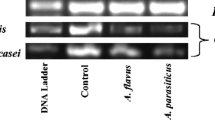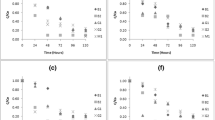Abstract
AflatoxigenicAspergillus flavus andAspergillus parasiticus were subjected to solid substrate fermentation process for 6 days to determine the formation of aflatoxins and production of extracellular enzymes (amyloglucosidase, cellulase, invertase and proteinase). Both organisms produced enzymes which generally increased with fermentation.Aspergillus flavus produced four enzymes whereasA. parasiticus produced three with no proteinase activity.Aspergillus parasiticus produced aflatoxins B1, B2 and G1 but no G2 andA. flavus produced aflatoxins B1 and B2. Invertase showed the highest activity withA. parasiticus and that corresponded with the highest total toxin produced. The enzyme activities were higher withA. parasiticus thanA. flavus although total toxins produced byA. parasiticus were lower than total toxins produced byA. flavus under the same environmental conditions.
Similar content being viewed by others
References
Aidoo KE, Hendry R, Wood BJB (1981) Amyloglucosidase and maltase activity in soy sauce fermentation. J Food Technology 16(5): 543–548.
Aidoo KE, Hendry, R, Wood BJB (1984) Mechanized fermentation systems for the production of experimental soy sauce Koji. J Food Tech 19: 389–398.
AOAC (1984)Official Methods of Analysis 14th Ed., AOAC, Arlington, VA, sections 26.008-26.012.
Brown RL, Chen ZY, Cleveland TE, Cotty PJ, Cary JW (2001) Variation inin vitro alpha-amylase and protease activity is related to the virulence ofAspergillus fiavus isolates. J Food Prot 64 (3): 401–404.
Elgerbi AM, Aidoo KE, Candlish AAG, Tester RF (2004) Occurrence of aflatoxin Ml in randomly selected North African milk and cheese samples. Food Additives Contam 21 (6): 592–597.
Karkalas J (1985) An improved enzymic method for the determination of starch and modified starch. J Sci Fd Agric 36: 1019–1027.
Matrai T, Mayer S, Kokai S, Salamon I (2000) Invertase production of common storage moulds in food and feed grains as a possibility for rapid detection ofAspergillus flavus group andAspergillus fumigatus. Int J Food Microbiol 61: 187–91.
Moss MO (1996) Mycotoxins: centenary review Mycology Res 100: 515–523.
Nout MJR (2002) Useful role of fungi in food processing. In Samson R A, Hoekstra E S, Frisvad J V, Filtenborg O (Eds) Introduction to Food-and Airborne Fungi. 6th. Edition. Centraalbureau voor Schimmelcultures, Utrecht, The Netherlands, p 364–374.
Nout MJR, Aidoo K E (2002) Asian Fungal Fermented Food. In Osiewacz ed. The Mycota X: Industrial Applications. Springer-Verlag Berlin, Heidelberg, p 23–47
Pearson SM, Candlish AAG, Aidoo KE, Smith JE (1999) Determination of aflatoxin levels in Pistachio Cashew nuts using immunoaffinity column clean up with HPLC and fluorescence detection. Biotechnology Techniques 13: 97–99
Samson RA, Hoekstra ES, Frisvad JV, Filtenborg O (2002) Introduction to Food and Airborne Fungi. 6th. Edition. Centraalbureau voor Schimmelcultures, Utrecht, The Netherlands.
Shenasi M, Aidoo KE, Candlish AAG (2002) The production aflatoxins in fresh date fruits and under simulated storage conditions. J Sci Food Agric 82: 848–853.
Viswanathan P, Surlikar N R (2001) Production of alpha-amylase withAspergillus flavus on Amaranthus grains by solid-state fermentation. J Basic Microbiol 41: 57–6715.
Weidenborner M, Wieczorem C, Appel S, Kunz B (2000) Whole wheat and white wheat flour — the mycobiota and potential mycotoxins. Food Microbiol 17: 103–107.
Author information
Authors and Affiliations
Corresponding author
Rights and permissions
About this article
Cite this article
Alzwei, A., Aidoo, K., Elgerbi, A. et al. Production of extracellular enzymes and aflatoxins in solid substrate fermentation with aflatoxigenicAspergillus spp.. Mycotox Res 20, 87–96 (2004). https://doi.org/10.1007/BF02946739
Received:
Revised:
Issue Date:
DOI: https://doi.org/10.1007/BF02946739




